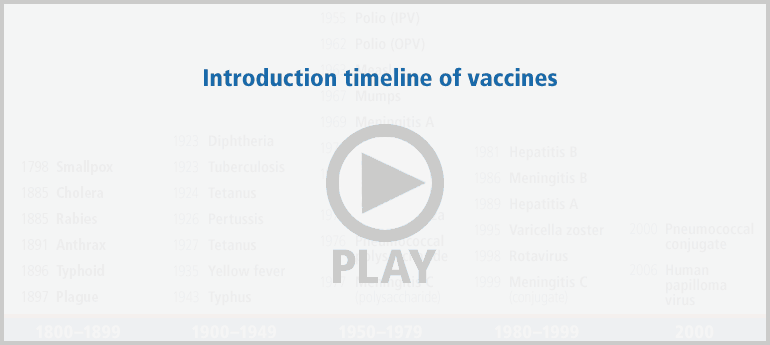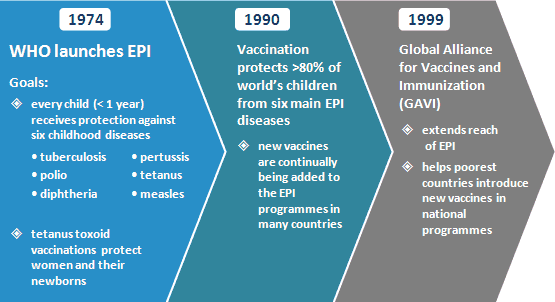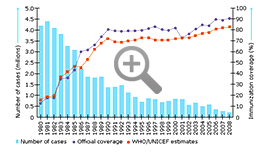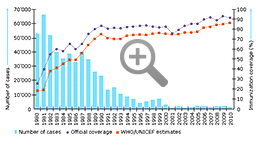History of vaccine development
You can read more about the state of the world's vaccines and immunization in this Executive Summary from WHO:
Executive Summary: State of the world's vaccines and immunizationAlthough inoculation![]() InoculationThe practice of intentionally exposing someone to matter from smallpox pustules in order to initiate a mild, protective response to the disease. against smallpox was practiced over 2000 years ago in China and India, a British physician, Edward Jenner, is generally credited with ushering in the modern concept of vaccination. In 1796 he used matter from cowpox pustules to inoculate patients successfully against smallpox, which is caused by a related virus
InoculationThe practice of intentionally exposing someone to matter from smallpox pustules in order to initiate a mild, protective response to the disease. against smallpox was practiced over 2000 years ago in China and India, a British physician, Edward Jenner, is generally credited with ushering in the modern concept of vaccination. In 1796 he used matter from cowpox pustules to inoculate patients successfully against smallpox, which is caused by a related virus![]() VirusAn ultramicroscopic infectious agent that consists of genetic material surrounded by a protein coat. A virus can replicate themselves only within cells of living hosts..
VirusAn ultramicroscopic infectious agent that consists of genetic material surrounded by a protein coat. A virus can replicate themselves only within cells of living hosts..
By 1900, there were two human virus vaccines, against smallpox and rabies![]() RabiesA potentially fatal viral infection spread through the bite of certain warm-blooded animals. It attacks the central nervous system and, if left untreated, is highly fatal in animals., and three bacterial vaccines against typhoid
RabiesA potentially fatal viral infection spread through the bite of certain warm-blooded animals. It attacks the central nervous system and, if left untreated, is highly fatal in animals., and three bacterial vaccines against typhoid![]() Typhoid (typhoid fever)A serious disease caused by a bacteria called Salmonella Typhi. Typhoid causes a high fever, weakness, stomach pains, headache, loss of appetite, and sometimes a rash. If it is not treated, it can kill up to 30% of people who get it. There are different vaccines to prevent typhoid: inactivated vaccines that require injection, and live attenuated vaccines that are taken orally (by mouth)., cholera
Typhoid (typhoid fever)A serious disease caused by a bacteria called Salmonella Typhi. Typhoid causes a high fever, weakness, stomach pains, headache, loss of appetite, and sometimes a rash. If it is not treated, it can kill up to 30% of people who get it. There are different vaccines to prevent typhoid: inactivated vaccines that require injection, and live attenuated vaccines that are taken orally (by mouth)., cholera![]() CholeraAn acute infectious disease of the small intestine, caused by the bacterium Vibrio cholerae and characterized by profuse watery diarrhea, vomiting, muscle cramps, severe dehydration, and depletion of electrolytes., and plague
CholeraAn acute infectious disease of the small intestine, caused by the bacterium Vibrio cholerae and characterized by profuse watery diarrhea, vomiting, muscle cramps, severe dehydration, and depletion of electrolytes., and plague![]() PlagueA serious, potentially life-threatening infectious disease that is usually transmitted to humans by the bites of rodent fleas. It was one of the scourges of early human history..
PlagueA serious, potentially life-threatening infectious disease that is usually transmitted to humans by the bites of rodent fleas. It was one of the scourges of early human history..
A worldwide case detection and vaccination programme against smallpox gathered pace and, in 1979, the World Health Assembly officially declared smallpox eradicated — a feat that remains one of history's greatest public health triumphs.
Question
Smallpox has been declared eradicated in 1979. Can you tell the difference between eradication and elimination of a disease? Select the two correct definitions for eradication and elimination of a disease:
| A. Eradication refers to the complete and permanent worldwide reduction to zero new cases of the disease through deliberate efforts. | |
| B. Eradication refers to the reduction to zero (or a very low defined target rate) of new cases in a defined geographical area. | |
| C. Elimination refers to the complete and permanent worldwide reduction to zero new cases of the disease through deliberate efforts. | |
| D. Elimination refers to the reduction to zero (or a very low defined target rate) of new cases in a defined geographical area. |
Answer A and D are correct.
Eradication![]() EradicationThe complete and permanent worldwide reduction to zero new cases of an infectious disease through deliberate efforts; no further control measures are required. refers to the complete and permanent worldwide reduction to zero new cases of the disease through deliberate efforts.
EradicationThe complete and permanent worldwide reduction to zero new cases of an infectious disease through deliberate efforts; no further control measures are required. refers to the complete and permanent worldwide reduction to zero new cases of the disease through deliberate efforts.
- If a disease has been eradicated, no further control measures are required.
Elimination![]() EliminationReduction to zero (or a very low defined target rate) of new cases of an infectious disease in a defined geographical area as a result of deliberate efforts; continued measures to prevent re-establishment of transmission are required. refers to the reduction to zero (or a very low defined target rate) of new cases in a defined geographical area.
EliminationReduction to zero (or a very low defined target rate) of new cases of an infectious disease in a defined geographical area as a result of deliberate efforts; continued measures to prevent re-establishment of transmission are required. refers to the reduction to zero (or a very low defined target rate) of new cases in a defined geographical area.
- Elimination requires continued measures to prevent re-establishment of disease transmission.
During the 20th century, other vaccines that protect against once commonly fatal infections such as pertussis![]() Pertussis (also known as whooping cough)An infectious bacterial disease caused by Bordetella pertussis that produces violent, spasmodic coughing; also called whooping cough., diphtheria
Pertussis (also known as whooping cough)An infectious bacterial disease caused by Bordetella pertussis that produces violent, spasmodic coughing; also called whooping cough., diphtheria![]() DiphtheriaA disease caused by toxigenic strains of Corynebacterium diphtheriae. Often marked by the formation of a false membrane in the throat, diphtheria is a serious vaccine-preventable disease that can cause death in unvaccinated children., tetanus
DiphtheriaA disease caused by toxigenic strains of Corynebacterium diphtheriae. Often marked by the formation of a false membrane in the throat, diphtheria is a serious vaccine-preventable disease that can cause death in unvaccinated children., tetanus![]() TetanusA disease caused primarily by toxigenic C. tetani. The rare but often fatal disease affects the central nervous system by causing painful muscular contractions., polio, measles
TetanusA disease caused primarily by toxigenic C. tetani. The rare but often fatal disease affects the central nervous system by causing painful muscular contractions., polio, measles![]() MeaslesA contagious viral disease marked by fever, the eruption of red circular spots on the skin that can be deadly to young and weakened individuals., rubella
MeaslesA contagious viral disease marked by fever, the eruption of red circular spots on the skin that can be deadly to young and weakened individuals., rubella![]() Rubella (German measles)A viral infection that is usually milder than measles but can cause serious damage or death to a fetus when a pregnant woman is infected., and several other communicable diseases were developed. As these vaccines became available, high-income industrial nations began recommending routine vaccination of their children. There are now over 20 vaccine-preventable diseases.
Rubella (German measles)A viral infection that is usually milder than measles but can cause serious damage or death to a fetus when a pregnant woman is infected., and several other communicable diseases were developed. As these vaccines became available, high-income industrial nations began recommending routine vaccination of their children. There are now over 20 vaccine-preventable diseases.

Based on the emerging success of the smallpox programme, in 1974, the World Health Organization (WHO) launched the Expanded Programme on Immunization (EPI)81. The initial EPI goals were to ensure that every child received protection against six childhood diseases (i.e. tuberculosis![]() Tuberculosis (TB) A disease caused by the bacterium Mycobacterium tuberculosis. The bacteria usually attack the lungs. But, TB bacteria can attack any part of the body such as the kidney, spine, and brain. If not treated properly, TB disease can be fatal., polio, diphtheria, pertussis, tetanus and measles) by the time they were one year of age and to give tetanus toxoid vaccinations
Tuberculosis (TB) A disease caused by the bacterium Mycobacterium tuberculosis. The bacteria usually attack the lungs. But, TB bacteria can attack any part of the body such as the kidney, spine, and brain. If not treated properly, TB disease can be fatal., polio, diphtheria, pertussis, tetanus and measles) by the time they were one year of age and to give tetanus toxoid vaccinations![]() Tetanus toxoid (TT) vaccine A preparation of tetanus toxoid used to immunize against tetanus. When given to women of childbearing age, vaccines that contain tetanus toxoid (TT or Td) not only protect women against tetanus, but also prevent neonatal tetanus in their newborn infants. to women to protect them and their newborns against tetanus.
Tetanus toxoid (TT) vaccine A preparation of tetanus toxoid used to immunize against tetanus. When given to women of childbearing age, vaccines that contain tetanus toxoid (TT or Td) not only protect women against tetanus, but also prevent neonatal tetanus in their newborn infants. to women to protect them and their newborns against tetanus.
Since then, new vaccines have become available. Some of them, such as hepatitis B![]() Hepatitis B A viral infection of the liver that is transmitted through contact with blood or other body fluids that are infected with the hepatitis B virus. Some infections, especially those acquired in infancy, can become chronic and result in cirrhosis and primary liver cancer in adulthood., rotavirus
Hepatitis B A viral infection of the liver that is transmitted through contact with blood or other body fluids that are infected with the hepatitis B virus. Some infections, especially those acquired in infancy, can become chronic and result in cirrhosis and primary liver cancer in adulthood., rotavirus![]() Rotavirus A group of viruses that cause diarrhea (rotaviral gastroenteritis) in children., Haemophilus influenzae type b (Hib)
Rotavirus A group of viruses that cause diarrhea (rotaviral gastroenteritis) in children., Haemophilus influenzae type b (Hib)![]() Haemophilus influenzae type b (Hib) Bacteria that can cause serious invasive illnesses, such as pneumonia and meningitis; most common in children and persons who are immune compromised (less able to fight off infections). Hib is one of six types of bacteria that are major causes of bacterial meningitis in unimmunized infants. and pneumococcal vaccines, are recommended by the WHO for global use. Others, such as yellow fever
Haemophilus influenzae type b (Hib) Bacteria that can cause serious invasive illnesses, such as pneumonia and meningitis; most common in children and persons who are immune compromised (less able to fight off infections). Hib is one of six types of bacteria that are major causes of bacterial meningitis in unimmunized infants. and pneumococcal vaccines, are recommended by the WHO for global use. Others, such as yellow fever![]() Yellow fever An infectious viral tropical disease transmitted by mosquitoes and characterized by high fever, jaundice, and gastrointestinal bleeding. vaccine, are recommended in countries where disease burden data indicate they should be used.
Yellow fever An infectious viral tropical disease transmitted by mosquitoes and characterized by high fever, jaundice, and gastrointestinal bleeding. vaccine, are recommended in countries where disease burden data indicate they should be used.
By 1990, vaccination was protecting over 80% of the world's children from the six main EPI diseases, and other new vaccines are continually being added to the EPI programmes in many countries.
In 1999, the Global Alliance for Vaccines and Immunization (GAVI) was created to extend the reach of the EPI and to help the poorest countries introduce new and under-used life-saving vaccines into their national programmes.

Although around 24 million infants are still not receiving the full complement of EPI vaccines in the first year of life, the success of the EPI can be judged by the reduction in worldwide cases of measles and poliomyelitis (see graphics). These two diseases are among several (including neonatal tetanus) targeted by the WHO for elimination through vaccination.
 |
 |
| Global annual reported incidence |
Global annual reported cases of Poliomyelitis |

